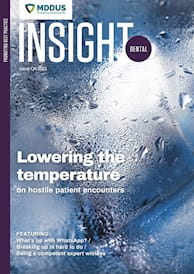BACKGROUND
Mr G attends his dentist – Dr K – for a routine check-up and scale/polish. Dr K notes that a distal surface filling on LL3 also needs to be replaced. An appointment is booked for the procedure.
A week later Mr G attends the surgery. A local anaesthetic is given and the procedure is undertaken, with no indication in the clinical records of any complications.
Three days later Mr G returns to the surgery complaining of an ulcerated area on the lower lip opposite LL3. He has already consulted his GP who has prescribed an antibiotic. Dr K explains that the ulcer is probably due to teeth rubbing against the lip or trauma from eating while anaesthetised. Mr G is advised to clean the ulcer with warm salt water. He is asked to re-attend the surgery in a few days to review.
Two weeks later Mr G returns to the surgery and the ulcer has healed. He informs Dr K that he obtained an opinion from another dentist who advised that the ulcer had been caused by the lip being pushed over the incisal edges of the lower teeth and spillage of acid etch gel onto his lip.
Dr K explains that the procedure was undertaken in the usual way, with cotton wool rolls placed in the sulcus to isolate the tooth, followed by aspiration of the acid gel. The dentist states that had there been any lip trauma or acid etch touching the tissues he would have advised Mr G immediately and recorded this in the clinical notes.
Dr K apologises for the discomfort and inconvenience Mr G has experienced and agrees to reimburse him for the cost of the treatment as a gesture of goodwill.
A letter is later received by the practice from solicitors acting for Mr G, claiming damages in relation to clinical negligence in his dental treatment. The letter alleges that Dr K failed to take due care in providing treatment of LL3 in allowing contact of excessive acid etch gel with broken tissue. The letter also states that the cotton wool was inadequately moistened, causing further damage to the lip tissue when being “torn” away.
It is further alleged that Mr G required an antibiotic to combat infection and continues to suffer discomfort, in addition to anxiety over future dental treatment.
ANALYSIS/OUTCOME
MDDUS acting on behalf of Dr K instructs an expert dental surgeon to assess the claim. The expert finds no record in the clinical notes of soft tissue trauma during the procedure. In subsequent statements, Dr K has confirmed his usual procedure in such cases, including use of moistened cotton wool to isolate the tooth and protect soft tissue from damage.
The expert also notes that when Mr G returned to the surgery with the ulcer, Dr K explained the likely cause to be trauma from the teeth when the lip was numb. The dentist provided advice on management of the ulcer and arranged to review the patient in a few days, which was a reasonable period to assess healing.
The expert concludes that in her opinion the most likely cause of the ulceration was from accidental trauma caused by biting or rubbing from teeth while the lip was numb from the local anaesthetic. Trauma caused by pulling the cotton wool away from the tissue was unlikely as the roll would have been moistened by Mr G’s saliva and the solution used to rinse away the acid etch.
A letter denying the claim is sent by MDDUS on behalf of Dr K and the case is subsequently discontinued.
KEY POINTS
- Clear and comprehensive clinical records are essential in defending against negligence claims.
- An apology or sincere expression of regret can often prevent a patient complaint escalating into a claim – but not always.
This page was correct at the time of publication. Any guidance is intended as general guidance for members only. If you are a member and need specific advice relating to your own circumstances, please contact one of our advisers.
Read more from this issue of Insight Dental

Save this article
Save this article to a list of favourite articles which members can access in their account.
Save to library
